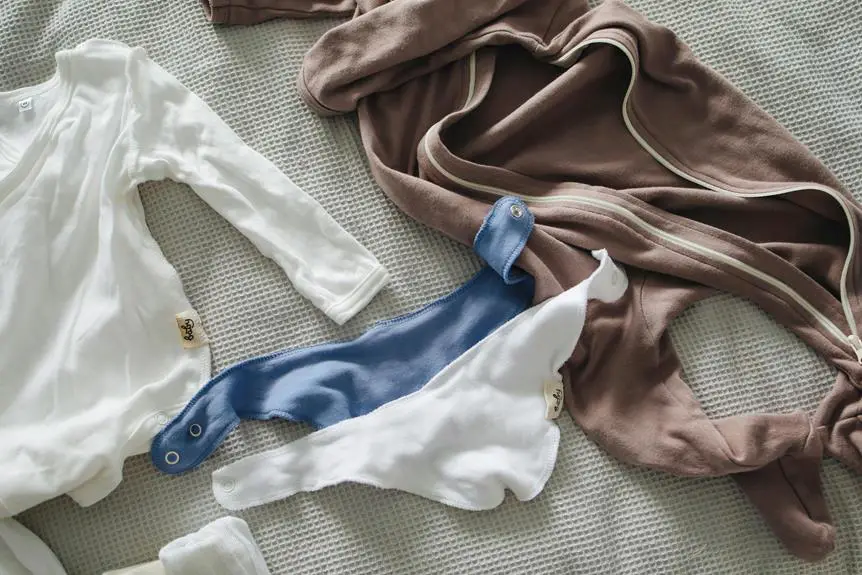When you're looking to prevent pinpoint from shrinking, it's crucial to start with the right care methods. You'll want to wash in cold water and dry on low heat to maintain the fabric's integrity. But it doesn't stop there; the materials you choose and how you store them play a significant role, too. Have you considered how temperature and humidity affect your garments? Exploring these factors can make a big difference in preserving your clothes, and there's so much more to uncover about effective strategies for maintaining their shape and longevity.
Table of Contents
Understanding Pinpoint Shrinkage
Pinpoint shrinkage occurs when specific areas of fabric lose their shape and size, often due to improper care or high heat exposure. This type of shrinkage is particularly noticeable in garments with delicate fibers or intricate weaves. When you wash or dry your clothes at high temperatures, the fibers can contract unevenly, leading to those unsightly wrinkles and tight spots.
To prevent pinpoint shrinkage, it's essential to pay attention to care labels. Always follow the recommended washing and drying instructions. You might think hot water or a high-heat dryer will clean your clothes better, but it can damage the fabric. Instead, opt for cold water washes and low-heat drying settings. If you're handwashing, gently agitate the fabric without stretching or twisting it.
Another crucial factor is how you store your garments. Hanging items too tightly or using improper hangers can cause stress on specific areas of the fabric, leading to distortion. By being mindful of these practices, you can maintain the integrity of your clothes and avoid pinpoint shrinkage effectively.
Choosing the Right Materials
Selecting the right materials for your garments can significantly reduce the risk of pinpoint shrinkage and enhance their longevity. Start by choosing fabrics known for their resistance to shrinking, such as cotton-polyester blends or pre-shrunk cotton. These options maintain their shape better than 100% cotton, which can be prone to shrinking after washing.
When considering synthetic materials like nylon or spandex, keep in mind that they often resist shrinkage, but ensure they're mixed with natural fibers for breathability and comfort. Look for fabrics labeled as “shrink-resistant” or “wash-and-wear” to further minimize the risk.
Also, pay attention to the weight of the fabric. Heavier materials tend to hold their shape better under stress and washing. Lightweight fabrics can be more susceptible to shrinkage, especially if they haven't been treated.
Proper Storage Techniques
When it comes to preventing pinpoint shrinking, proper storage techniques are crucial.
You'll want to maintain ideal temperature conditions and control humidity levels to protect your materials.
Using sealed containers can also make a significant difference in preserving their quality.
Ideal Temperature Conditions
Maintaining a stable temperature in your storage area is crucial for preventing unwanted shrinkage in your fabrics. Extreme temperature fluctuations can cause fibers to contract, leading to that frustrating pinpoint shrinkage.
To keep your fabrics in top condition, follow these ideal temperature conditions:
- Keep it cool: Aim for a temperature between 60°F to 75°F (15°C to 24°C) for optimal fabric preservation.
- Avoid direct sunlight: Store your fabrics in a shaded area to prevent heat buildup and UV damage.
- Monitor temperature fluctuations: Use a thermometer to regularly check the storage area's temperature for any sudden changes.
- Choose the right storage container: Opt for breathable containers, like cotton bags, instead of plastic, which can trap heat.
Humidity Control Methods
Regularly controlling humidity levels is essential to keep your fabrics safe from pinpoint shrinkage. High humidity can cause fabrics to absorb moisture, leading to distortion and shrinkage over time. To prevent this, you should aim to maintain a stable humidity range of 30-50% in your storage area.
Start by using a hygrometer to monitor humidity levels. If you notice that the humidity is too high, consider using a dehumidifier to help reduce moisture in the air. Additionally, you can place moisture-absorbing materials, like silica gel packets or activated charcoal, near your stored fabrics to absorb excess humidity.
It's also crucial to store your fabrics in well-ventilated spaces. Avoid tight, enclosed areas where moisture can get trapped. If possible, opt for breathable storage bags or containers that allow air circulation.
When cleaning your fabrics, ensure they're completely dry before storing them. Even a small amount of residual moisture can lead to issues over time.
Sealed Container Usage
Using sealed containers is an effective way to protect your fabrics from environmental factors that can lead to pinpoint shrinkage. These containers create a controlled environment that minimizes exposure to moisture, dust, and fluctuating temperatures. By storing your fabrics properly, you can significantly reduce the risk of damage.
Here are some tips for using sealed containers effectively:
- Choose airtight containers: Opt for plastic bins with tight-fitting lids or vacuum-sealed bags to block out air and humidity.
- Clean and dry fabrics: Always ensure your fabrics are clean and completely dry before storing them to prevent mold growth.
- Use moisture absorbers: Consider adding silica gel packets or other desiccants inside the containers to absorb any residual moisture.
- Label the containers: Clearly mark each container with the contents and storage date to keep track of your fabrics easily.
Managing Temperature and Humidity
Controlling temperature and humidity levels in your home is crucial to preventing pinpoint shrinking in your wood furniture. Wood is a natural material that responds to environmental changes, and fluctuations in temperature and humidity can lead to unwanted shrinking and expansion.
To maintain optimal conditions, aim for a consistent indoor temperature between 60°F to 80°F (15°C to 27°C) and humidity levels around 30% to 50%. You can use a hygrometer to monitor humidity and a thermometer for temperature.
Here's a quick reference table to help you manage these factors:
| Factor | Ideal Range |
|---|---|
| Temperature | 60°F – 80°F (15°C – 27°C) |
| Humidity | 30% – 50% |
| Daily Variation | Less than 5% |
| Seasonal Adjustment | Gradual changes only |
Regular Maintenance Practices
To keep pinpoint shrinking at bay, you need to adopt regular maintenance practices.
Establishing a routine cleaning schedule, using proper storage techniques, and regularly inspecting for damage can make a significant difference.
Let's explore how each of these points can help protect your items.
Routine Cleaning Schedule
Establishing a regular cleaning schedule helps you maintain your items and prevent pinpoint shrinking over time. By incorporating consistent cleaning into your routine, you can effectively extend the lifespan of your belongings.
Here are some essential practices to include in your schedule:
- Dust regularly: Wipe down surfaces to remove dust that can accumulate and affect the material.
- Check for stains: Address any stains immediately to prevent them from setting in and causing damage.
- Wash according to care labels: Always follow the manufacturer's instructions for washing to preserve the integrity of the fabric.
- Inspect for wear and tear: Regularly check your items for signs of damage, so you can repair them before they worsen.
Proper Storage Techniques
Proper storage techniques can significantly reduce the risk of pinpoint shrinking and keep your items in great condition.
First, always choose a cool, dry place for storage. High humidity can lead to mold and mildew, which contribute to shrinking. You might consider using dehumidifiers or silica gel packets to control moisture levels.
Next, avoid overcrowding your storage space. When items are packed too tightly, they can become compressed and lose their shape. Use storage bins or boxes that allow some air circulation, preventing your items from getting squished.
Additionally, keep away from direct sunlight. UV rays can weaken materials over time, leading to shrinkage. Use opaque storage containers or cover your items with breathable fabrics to shield them from light.
Lastly, if you're storing textiles, make sure they're clean and completely dry before putting them away. Storing damp or dirty items can lead to permanent damage.
Inspection for Damage
Regularly inspecting your items for damage is just as important as storing them correctly, as it helps catch any potential issues before they lead to pinpoint shrinking.
By making inspection a part of your routine, you can identify and address problems early, ensuring your items remain in great condition.
Here are some key areas to focus on during your inspections:
- Surface Scratches: Look for any visible marks that may compromise the material's integrity.
- Seams and Stitching: Check for frays or loose threads that could result in further damage.
- Moisture Damage: Inspect for signs of mold or dampness, which can weaken your items.
- Fasteners and Zippers: Ensure that all closures are functional and not putting stress on the surrounding material.
Utilizing Effective Tools and Equipment
To prevent pinpoint shrinking, you should invest in high-quality tools and equipment designed specifically for your fabric type.
Start with a reliable washing machine that offers gentle cycles, as this helps maintain fabric integrity. Look for machines with adjustable settings tailored to delicate fabrics; these features can make a significant difference.
Next, consider using a quality detergent formulated for sensitive materials. Avoid harsh chemicals that can break down fibers, leading to shrinkage.
When drying, opt for a low-heat setting or air drying to prevent excessive heat exposure, which is a common cause of shrinking.
Investing in specific drying racks or hangers can also be beneficial. These tools help keep your fabrics in shape while they dry, reducing the risk of distortion that can lead to shrinkage. Additionally, using a steamer instead of an iron can help you remove wrinkles without direct heat, preserving your fabric's structure.
Lastly, don't underestimate the value of proper storage solutions. Use breathable garment bags or cotton covers to protect your fabrics from humidity and pests when not in use.
With the right tools and equipment, you can significantly reduce the chances of pinpoint shrinking.
Frequently Asked Questions
Can I Use Fabric Softener to Prevent Pinpoint Shrinkage?
You can use fabric softener, but it won't necessarily prevent pinpoint shrinkage. It may help soften the fabric, making it feel nicer, but consider other methods for effective shrinkage prevention instead.
How Often Should I Check for Pinpoint Shrinkage?
You should check for pinpoint shrinkage regularly, ideally after each wash. This way, you can catch any issues early and adjust your care routine to maintain the fabric's quality and fit over time.
What Are the Signs of Impending Pinpoint Shrinkage?
You'll notice signs of impending pinpoint shrinkage when the surface appears uneven, color changes, or you spot cracks. Keep an eye on these indicators to address any issues before they worsen and affect performance.
Is Pinpoint Shrinkage Reversible Once It Occurs?
Yes, pinpoint shrinkage can be reversible, but it depends on the extent of damage. You should act quickly, using appropriate treatments, to maximize recovery chances and restore your pinpoint to its original state.
Can Washing Methods Affect Pinpoint Shrinkage?
Yes, washing methods can definitely affect pinpoint shrinkage. If you use hot water or high heat in the dryer, you're more likely to see shrinkage. Stick to colder settings to minimize this risk.
- How Does Ring Spun Cotton Affect Garment Fit and Shape Retention? - August 13, 2024
- What Are the Challenges in Producing Ring Spun Cotton? - August 13, 2024
- Is Ring Spun Cotton Suitable for Plus-Size Clothing? - August 13, 2024







